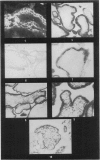Abstract
The syncytiotrophoblast of chorionic villi of normal human mid-pregnancy placenta maintained in organ culture in a chemically-defined medium loses its various differentiated characters at different rates. Although certain oxidative and hydrolytic enzymes are retained for periods of 1-6 weeks and human placental lactogen persists in the cytoplasm for about 2 weeks, the enzyme 3β-hydroxysteroid dehydrogenase and the “steroid-synthesizing cell” antigen are lost after culture for 1 and 2 days respectively. These two characters reappear in cytotrophoblast that is newly differentiated during culture. It is concluded that organ cultures of this type will not be suitable for metabolic studies on the biosynthesis of steroid hormones by the placenta.
Full text
PDF









Images in this article
Selected References
These references are in PubMed. This may not be the complete list of references from this article.
- Anderson J. R., Goudie R. B., Gray K., Stuart-Smith D. A. Immunological features of idiopathic Addison's disease: an antibody to cells producing steroid hormones. Clin Exp Immunol. 1968 Feb;3(2):107–117. [PMC free article] [PubMed] [Google Scholar]
- Beck J. S., Gordon R. L., Donald D., Melvin J. M. Characterisation of antisera to a growth-hormone-like placetal antigen (human placental lactogen): immunofluorescence studies with these sera on normal nd pathological syncytiotrophoblast. J Pathol. 1969 Mar;97(3):545–555. doi: 10.1002/path.1710970313. [DOI] [PubMed] [Google Scholar]
- Boyd J. D., Hamilton W. J. Electron microscopic observations on the cytotrophoblast contribution to the syncytium in the human placenta. J Anat. 1966 Jul;100(Pt 3):535–548. [PMC free article] [PubMed] [Google Scholar]
- Gerbie A. B., Hathaway H. H., Brewer J. I. Autoradiographic analysis of normal trophoblastic proliferation. Am J Obstet Gynecol. 1968 Mar 1;100(5):640–648. doi: 10.1016/s0002-9378(15)33389-5. [DOI] [PubMed] [Google Scholar]
- Goldman A. S. Stoichiometric inhibition of various 3-beta-hydroxysteroid dehydrogenases by a substrate analogue. J Clin Endocrinol Metab. 1967 Mar;27(3):325–332. doi: 10.1210/jcem-27-3-325. [DOI] [PubMed] [Google Scholar]
- Hou L. T., Beck J. S. Persistence of a growth hormone-like antigen in organ cultures of human placentas. Experientia. 1967 Oct 15;23(10):846–848. doi: 10.1007/BF02146882. [DOI] [PubMed] [Google Scholar]
- Hou L. T., Ewen S. W., Beck J. S. Histological, metabolic and histochemical studies on normal human placenta in organ culture. Br J Exp Pathol. 1968 Dec;49(6):648–657. [PMC free article] [PubMed] [Google Scholar]
- Knoth M., Pattillo R. A., Garancis J. C., Gey G. O., Ruckert A. C., Mattingly R. F. Ultrastructure and hormone synthesis of choriocarcinoma in vitro. Am J Pathol. 1969 Mar;54(3):479–488. [PMC free article] [PubMed] [Google Scholar]
- Li C. H., Grumbach M. M., Kaplan S. L., Josimovich J. B., Friesen H., Catt K. J. Human chorionic somato-mammotropin (HCS), proposed terminology for designation of a placental hormone. Experientia. 1968 Dec 15;24(12):1288–1288. doi: 10.1007/BF02146676. [DOI] [PubMed] [Google Scholar]
- Nicol A. G., Beck J. S. Persistence of an organ-specific antigen in organ and tissue cultures of hyperplastic human thyroid gland. Nature. 1966 Jun 18;210(5042):1227–1229. doi: 10.1038/2101227a0. [DOI] [PubMed] [Google Scholar]
- Porteous I. B., Beck J. S., Pugh R. C. Localisation of human placental factor in malignant teratoma of testis. J Pathol Bacteriol. 1968 Apr;95(2):527–535. doi: 10.1002/path.1700950226. [DOI] [PubMed] [Google Scholar]
- Subak-Sharpe H., Bürk R. R., Pitts J. D. Metabolic co-operation between biochemically marked mammalian cells in tissue culture. J Cell Sci. 1969 Mar;4(2):353–367. doi: 10.1242/jcs.4.2.353. [DOI] [PubMed] [Google Scholar]
- TAO T. W., HERTIG A. T. VIABILITY AND DIFFERENTIATION OF HUMAN TROPHOBLAST IN ORGAN CULTURE. Am J Anat. 1965 Jan;116:315–327. doi: 10.1002/aja.1001160116. [DOI] [PubMed] [Google Scholar]
- Taki I., Iijima H., Uetsuki M., Hamanaka N., Morishita M., Mori M. Histochemical studies of steroid 3-beta-ol dehydrogenases of the human ovaries. Am J Obstet Gynecol. 1967 May 1;98(1):107–115. doi: 10.1016/0002-9378(67)90139-1. [DOI] [PubMed] [Google Scholar]




